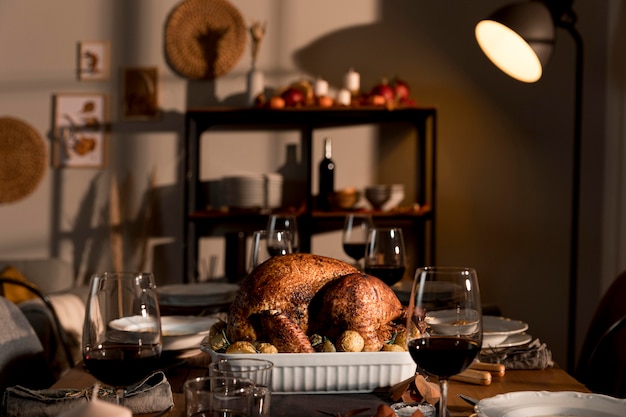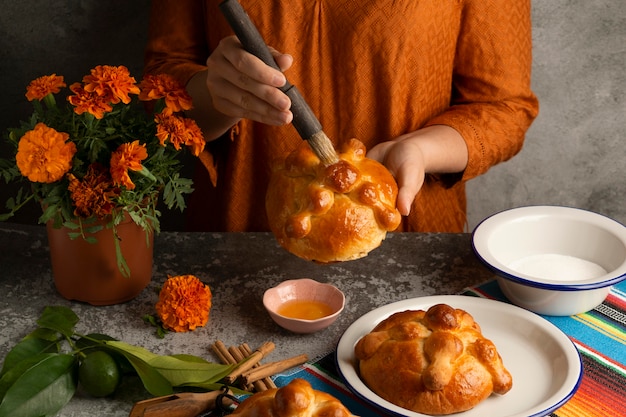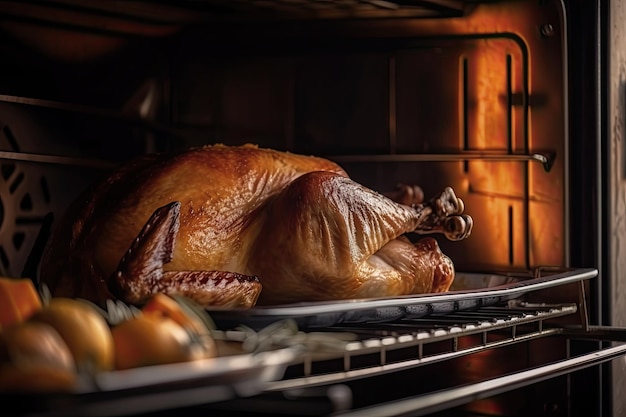Ah, Christmas. The smell of pine needles, the twinkling lights, and the anticipation of a delicious feast. But let's be real, the centerpiece of any Christmas dinner is the turkey. Now, I'm not talking about any old turkey - I'm talking about a magnificent 23lb behemoth. And that, my friends, is where the real challenge begins: figuring out how long to roast that big bird. You want it cooked through, juicy, and delicious, but you also don't want it to dry out or turn into a rubbery, inedible mess. Trust me, I've been there, standing over a roasting pan, a little stressed about the timing. That's why I've put together this ultimate guide to roasting a 23lb turkey, drawing on my years of experience and a few tips and tricks I've learned along the way. Let’s get started!
Part 1: Prepping Your Turkey for Roasting

First things first, we need to get your turkey ready for its star turn in the oven. This might sound simple, but it's crucial for a successful roast. Here's what I recommend:
1. Thaw It Out: Patience is Key
The first step, and perhaps the most important, is thawing your turkey. Now, I know this might seem like a hassle, but it's essential for proper cooking. No one wants to carve into a frozen bird, right? You can thaw your turkey in the fridge, which takes a whole day for every 5 pounds of bird. So, for a 23lb turkey, that's almost 5 days! If you don't have that much time, you can thaw it in cold water, which takes about 30 minutes per pound. That means a 23lb turkey will take about 11 and a half hours to thaw in cold water. Just make sure you change the water every 30 minutes and keep the turkey submerged.
2. Pat It Dry: For a crispy skin
Once your turkey is completely thawed, give it a good pat down with some paper towels. You want to get rid of any excess moisture, which can lead to steam and make your skin less crispy. I've learned this lesson the hard way - you don't want your turkey to be soggy! Trust me, the crispy skin is a crucial part of the experience.
3. Season It Up: The Flavor Factor
Now comes the fun part: seasoning! There are endless possibilities here, and I love experimenting with different herbs and spices. But a classic combination that always works is salt, pepper, and a little bit of paprika. I also like to add a bit of garlic powder, onion powder, and thyme. Don't be shy with the seasoning! Rub it all over the turkey, getting it under the skin as well. This will ensure that the meat is seasoned through and through, resulting in a flavorful turkey.
4. Truss It Up: For Even Cooking and a Beautiful Presentation
Trust me, trussing your turkey will make a world of difference. It helps the bird cook evenly and keeps the legs from splaying out. It’s a simple technique, and there are lots of tutorials online. I usually use kitchen twine to tie the legs together and tuck the wings under the bird. Not only does this help with cooking, but it also makes your turkey look much more presentable when you bring it to the table.
Part 2: Roast It Right: Mastering the Timing

Now, the moment of truth: roasting the turkey. Here’s where we need to talk about cooking times. Everyone seems to have their own secret recipe, but I've found that a consistent roasting time of about 15 minutes per pound is a good starting point for a 23lb bird. So, for your 23lb turkey, you're looking at roughly 345 minutes, which is about 5 hours and 45 minutes. Sounds like a long time, right? It is, but it's worth it for a juicy, flavorful turkey. Now, here's the thing: I always check the temperature with a meat thermometer. You want the turkey to reach 165°F (74°C) in the thickest part of the thigh.
1. Get the Oven Ready: Setting the Stage for Success
Start by preheating your oven to 325°F (163°C). I always put a roasting rack on a baking sheet, and then place the turkey on top of that. This helps to allow the air to circulate around the turkey, which leads to more even cooking. I also recommend placing a drip pan underneath the roasting rack to catch any juices that drip out.
2. Roast It With Love: The Key is Patience
Place your trussed, seasoned turkey into the preheated oven and let it roast. Now, here's where things get interesting. You’ll want to baste the turkey every hour or so with the pan juices. This keeps the bird moist and flavorful. I use a spoon or a baster to pour the juices over the turkey, making sure to get it all over.
3. Rest It: The Secret to Tenderness
Once your turkey is cooked through, it's crucial to let it rest for at least 30 minutes before carving. This allows the juices to redistribute, ensuring a succulent and juicy turkey. I usually cover the turkey loosely with foil while it rests, keeping it warm. This is a crucial step that many people skip, but it really makes a difference in the final product.
Part 3: Don't Forget the Sides!

You've got the turkey sorted, but what about the sides? After all, the turkey is just the star of the show. Here are a few of my go-to side dishes that pair perfectly with roast turkey:
1. roast potatoes: The Classic Companion
What's a Christmas dinner without crispy roast potatoes? I love to toss them in some olive oil, salt, and pepper, then roast them in the oven until they're golden brown and crispy on the outside. To take things up a notch, I add some rosemary sprigs to the pan for a delicious aroma. They add a lovely earthy flavor that complements the turkey perfectly.
2. Stuffing: A Thanksgiving Staple
Stuffing is a classic side dish, and I love to make a homemade one with bread cubes, onions, celery, and sausage. I always cook the stuffing separately, for safety reasons. For a richer flavor, I often add dried cranberries and pecans to my stuffing.
3. Gravy: A Must-Have for Turkey
You can't have roast turkey without gravy! I use the pan juices to make a rich and flavorful gravy, adding some flour and stock to thicken it up. For a more decadent gravy, I sometimes add a splash of red wine or a spoonful of Dijon mustard.
4. Brussels Sprouts: A Surprising Delight
Don't turn your nose up at brussels sprouts. They're actually incredibly delicious when roasted with some bacon and balsamic vinegar. They get a lovely caramelized flavor and a touch of sweetness from the balsamic vinegar that balances out the savory notes of the bacon.
5. Cranberry Sauce: A Festive Tradition
No Christmas dinner is complete without a dollop of cranberry sauce. I love to make a homemade version with fresh cranberries, orange juice, and sugar. But if you're short on time, store-bought cranberry sauce will do just fine.
Part 4: The Ultimate Turkey Roast Table: A Guide to Timing
Here's a table summarizing the roasting times for a 23lb turkey based on oven temperature and method:
| Oven Temperature (°F) | Method | Roasting Time (hours) |
|---|---|---|
| 325°F (163°C) | Conventional Oven | 5.75 - 6.5 |
| 400°F (204°C) | High Heat | 4 - 4.5 |
Remember, these are just estimates. Always check the internal temperature of the turkey with a meat thermometer to ensure it's cooked through. It's better to err on the side of caution and let it cook a bit longer than to undercook it. You want to make sure it's safe to eat!
Part 5: Tips and Tricks for a perfect roast: Elevate Your Turkey Game
Okay, let's talk about some tips and tricks that will take your turkey roasting game to the next level.
1. Don't Overcrowd the Oven: Space is Key
If you're roasting other dishes alongside your turkey, make sure you don't overcrowd the oven. This can lead to uneven cooking and your turkey won't get the proper airflow it needs to cook evenly. Try to give your turkey plenty of space in the oven so it can roast properly.
2. Use a Thermometer: The Key to Success
As I mentioned earlier, I always use a meat thermometer to check the internal temperature of the turkey. It's the only way to be sure it's cooked through. This is especially important for a larger turkey like a 23lb bird, as it takes longer to cook and it's easy to overcook it if you rely solely on visual cues.
3. Keep the Skin Crispy: The Secret to a Delicious Finish
I've found that basting the turkey with butter or olive oil in the last 30 minutes of roasting helps to achieve crispy skin. This is a crucial step for a beautiful and delicious presentation. You can also use a kitchen torch to crisp up the skin in the last few minutes of cooking.
4. Don't Overcook It: Tenderness is Key
The key to a juicy turkey is not overcooking it. Make sure to check the temperature and take it out of the oven when it's reached 165°F (74°C). Overcooked turkey can be dry and tough, so it's important to take it out of the oven before it reaches that point. If you're unsure, err on the side of undercooked and let it rest longer, as it will continue to cook a bit even after it's removed from the oven.
Part 6: What to Do with Leftovers: Transform Leftover Turkey
Let's face it, you'll probably have some leftover turkey after a big Christmas dinner. But don't fret, there are tons of delicious ways to use it up!
1. turkey sandwiches: A Classic comfort food
A classic for a reason! Slice the turkey, add some cranberry sauce, and enjoy a delicious turkey sandwich. You can also add some lettuce, tomato, and mayonnaise for a more substantial sandwich.
2. turkey soup: A Hearty and Comforting Meal
A comforting and hearty soup, perfect for a cold winter day. Combine turkey, vegetables, and broth for a satisfying meal. You can also add some noodles or rice for a more substantial soup.
3. turkey salad: A Light and Refreshing Option
A light and refreshing salad that's perfect for lunch or a snack. Mix diced turkey with celery, mayonnaise, and your favorite seasonings. You can also add some chopped grapes or pecans for a more complex flavor profile.
4. turkey pot pie: A Delicious and easy recipe
A delicious and easy way to use up leftover turkey. Combine turkey, vegetables, and gravy in a pot pie crust and bake until golden brown. You can use a store-bought pie crust for a quick and easy meal.
Part 7: FAQs: Addressing Common Concerns
Now, I’m sure you've got some questions. Let’s address some of the most common ones:
1. Can I Roast a frozen turkey?
While it's possible to roast a frozen turkey, I strongly recommend against it. The turkey won't cook evenly, and it might end up undercooked or dry. Always thaw your turkey completely before roasting. It's simply not worth the risk of undercooked turkey.
2. How Long Should I Let the Turkey Rest?
I recommend letting the turkey rest for at least 30 minutes after roasting. This allows the juices to redistribute and ensures a juicy and flavorful turkey.
3. What Temperature Should I Roast the Turkey At?
I recommend roasting your turkey at 325°F (163°C). This is a consistent temperature that leads to even cooking and juicy results.
4. How Do I Know When the Turkey Is Done?
The best way to know if your turkey is done is to check the internal temperature with a meat thermometer. You want the thickest part of the thigh to reach 165°F (74°C).
5. What Should I Do if the Turkey Is Browning Too Quickly?
If you notice the turkey is browning too quickly, you can tent it with foil to slow down the browning process. You can also reduce the oven temperature slightly.
Part 8: Final Thoughts: Embrace the Festive Feast
So there you have it, my ultimate guide to roasting a 23lb turkey. Remember, it's all about planning, prepping, and patience. Don't be afraid to experiment with different seasonings and sides, and enjoy the process! I know I do. After all, Christmas dinner is about bringing loved ones together and enjoying a delicious feast. Happy holidays!
Everyone is watching

Corn on the Cob: The Ultimate Guide to Perfectly Cooked Ears
Healthy MealsAh, corn on the cob. Just the name evokes images of sunny days, barbecues, and that sweet, juicy flavour that ...

Perfect Pork Roast Oven Cooking Time: A Guide to Delicious Results
Healthy MealsThere's something truly satisfying about a perfectly roasted pork. The aroma alone is enough to make your mout...

Scallops: The Ultimate Guide to Perfect Cooking
Healthy MealsAh, scallops. Those delicate, sweet, and utterly delicious morsels of the sea. They hold a special place in my...

Ham Cooking Time: How Long to Bake, Smoke, or Boil a Delicious Ham
Healthy MealsAh, ham. It's a classic, isn't it? A real crowd-pleaser, especially around holidays. And when done right, it'...

Spaghetti Squash: The Ultimate Guide to Cooking and Serving
Healthy MealsRemember that time you saw spaghetti squash at the supermarket, looking all bumpy and strange, and thought, "W...
